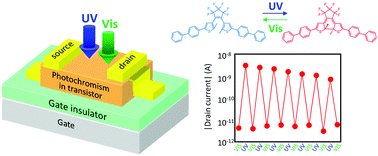Photochromism for optically functionalized organic field-effect transistors: a comprehensive review
Abstract
Photochromic molecules exhibit photoresponsive variations in their physical properties. For example, energy level, π-conjugation, dipole moment, ionic state and steric conformation can be changed reversibly with alternate UV-visible light illumination. Photochromism has already been proposed for application to various optoelectronic devices. However, practical progress on such applications only became evident after the recent noteworthy developments on organic field-effect transistors (OFETs). This article reviews various applications of such photochromism in organic electronics. First, the photoswitching properties of electrical currents passing through single photochromic molecules are briefly overviewed. Second, effective applications of photochromic reactions in two-dimensional thin film-based diodes are introduced. These studies provided the basis for subsequent developments in OFETs. Finally, recent advances regarding photochromism in OFETs are emphasized as realistic optoelectronic applications.

- This article is part of the themed collection: Journal of Materials Chemistry C Recent Review Articles


 Please wait while we load your content...
Please wait while we load your content...